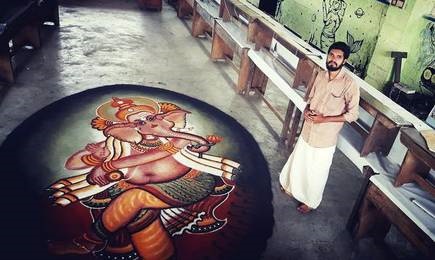The vivid designs of “kalamezhuthu” represent the beliefs of the people of Kerala, a state located in southern India, where this temple art was created and elevated.

Let’s just visualize… The air is light, fresh and fragrant. The incense sticks are lit near the idols and the thin line of smoke that escapes from them, adds to the ambience of meditation. Inside this temple in South India, the white of the jasmine flowers, the orange of the priests’ robe, the red of the embellishments on the walls, offer a colorful rapture, both humble and soothing to the mind. And then, boldly standing out on the entrance floor, and participating in the tranquil dramaturgy of the place: the “kalamezhuthu“.
The ritual art of “kalamezhuthu” tells several religious stories through its large vivid drawings of gods and goddesses, finely illustrated on the floors of most temples in South India, especially those of the Hindu goddess Bhagvathy or Bhadrakali.
Comparable to rangoli or komal from other parts of India, kalamezhuthu is made using coloured powders. In South India, the temple art and the motifs of the “kalamezhuthu” depict deities expressing intense emotions or are inspired by various celebrations. The situations and emotions represented come more from the age-old representation of rituals than from an elaborate art form. From the knowhow and patterns available, although the designs, details and articles are pre-meditated; the patterns simply shape through the religious customs. Pureness of this art is also evident in the natural pigments used: white, yellow, green and black are prepared from rice, leaves, turmeric and rice straw. They are the only ones to be used to represent the deities.

The “kalamezhuthu” adds to the mysticism of the temples by its vivid representations of the goddess “Kali” or the god “Ayyappa” taken from the legends of this region. “Kalam” in Malayalam, the regional language of Kerala, means “image” and “ezhuthu” translates “the act of drawing”. This art highlights the beliefs of the people of Kerala.
Faith at the center of art
The “kalamezhuthu” ritual is articulated in three stages around religious, aesthetic and social aspects. First, the drawing, or “kalamezhuthu”, then the “Kalam Pattu” which consists of the interpretation of the myth linked to the divinity, and finally the “Kalam Thullal” where the drawing is erased while the artists dance in the hall. The rhythm of traditional drums. The drawing is made at a defined time before being erased as soon as the rituals linked to the “kalam” are completed.
“Kalamezhuthu” artists generally belong to communities such as Kurups, Theyyampadi Nambiars, Theeyadi Nambiars or Theeyadi Unnis. Although each community has pictorial specificities, the rituals surrounding this art remain the same.

The “kalamezhuthu” participates in religious celebrations in temples or other rituals such as ‘nagapuja’, a prayer in honor of the Hindu serpent god, naga devata. Usually, drummers, the artists themselves officiate the ceremonies. Rice and other grains offered are piled near the drawing.
Dimly lit by oil lamps, the grace of the sacred space is emphasized by the decorations of flowers, leaves and garlands that are part of the celebrations. The temple resonates with songs, classical or folk, according to the venerated deity. Legacy of an oral tradition perpetuated by the artists themselves, these ritual songs are accompanied by musical instruments like the ilathalam, the veekkanchenda, the kuzhal, the kombu, or chenda.
Aashi is a working PR professional who enjoys a good amount of her free time reading, cooking, and taking care of her 2 dogs.